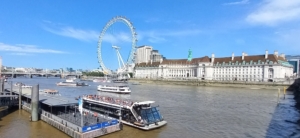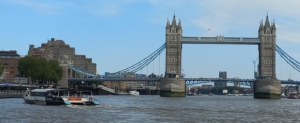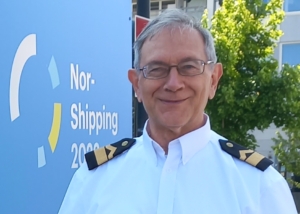Electric ships on the Thames from British and Polish shipyards


 By Marek Grzybowski
By Marek Grzybowski
Earth Clipper floated onto the Thames in the summer. This is the first hybrid high-speed passenger ship in Europe, built in accordance with the High-Speed Craft Code. It joined the plug-in hybrid vessel ferries built in Remontowa (fast loaded from land during a short stop), which transport passengers and cars between the banks of the Thames in Woolwich.
The first of three new passenger ships on the Thames was introduced by Uber Boat by Thames Clippers. which operates services between London passenger piers. A new ferry sails in central London. The hybrid propulsion system allows the new vessels to operate solely on battery power while transporting commuters and tourists visiting London.
The ferries are designed to sail within Central London. The primary route will serve a link between Tower Pier and Battersea Power Station Pier. The batteries are charged using energy from biofuel-powered engines. Bunkering stations are located outside central London.
Catamaran powered by biofuel and batteries
The ships will use excess power from their biofuel engines to charge their batteries while crossing the Thames between central London piers.
Earth Clipper delivers an almost 90 percent reduction in CO2 emissions compared to operating solely on conventional marine diesel, the operator claims. This is the 18th fast catamaran in the Uber Boat by Thames Clippers fleet, operating passenger connections on the Thames. It is not only the first but also the largest hybrid unit in passenger transport on the Thames.
– It is 40 m long – almost the length of two tennis courts connected together – and can accommodate 230 passengers – explains the operator graphically.
Earth Clipper was also designed with optimal tourist comfort in mind. The passenger area has large windows overlooking the buildings and waterfront along the banks of the Thames.
“This is a momentous day for us and something we’ve been working on for some time,” said Sean Collins, co-founder and CEO of Uber Boat by Thames Clippers, as the ship was launched.
Eco-friendly Uber plows the waters of the Thames
– The ability to provide greener transport through the capital is no small feat, but something we are incredibly passionate about at Uber Boat by Thames Clippers, emphasizes Collins, noting: “We want to not only use the most advanced technology to reduce our carbon footprint, but also play our part a role in opening up new opportunities to push this technology to its maximum potential.”
Collins emphasizes that “The new boats push the boundaries of catamaran design, providing a future-proof option that can be even greener if and when technology allows.”
– We are also happy to announce that Earth Clipper will be joined by two sister ships. Celestial and Mars Clipper will be added to the fleet this year as we work to achieve our goals of reducing greenhouse gas emissions by 50% by 2030 and achieving net zero emissions by 2040 across the business, Collins said.
Hybrids for the Thames
The operator plans to introduce a hybrid system on all new ships sailing to the Thames. Wherever possible, technology based on a fully electric gym will be introduced.
– In addition to the three hybrid catamarans, work is underway to deliver London’s first fully electric, zero-emission Cross River ferry, says the operator.
It will operate services between Canary Wharf and Rotherhithe from spring 2025. The company’s plans for 2030 include a £70 million investment in the new fleet. For over 20 years, the company has focused on driving innovation in the river transport sector and is committed to supporting sustainable infrastructure and economic development on the Thames within Greater London.
Earth Clipper was built at Wight Shipyard Co in East Cowes on the Isle of Wight, where finishing work is currently underway on two sister ships.
“The investment has also had a significant impact on the local economy on the Isle of Wight. Over the last year, it provided employment to 65 people building the ship and 14 students working with them.
From Remontowa to the Thames
It is worth recalling that ferries were also built in Poland to service connections on the Thames. Remontowa Shipbuilding built plug-in hybrid vessel ferries (quickly loaded from land during a short stay) carrying passengers and cars between the banks of the Thames over 5 years ago. They connect London districts located near flood barriers and the City Airport.
Passenger and car ferries with a length of over 60 m have a load line of approximately 210 m. They can accommodate 150 passengers and 45 cars. They were built at the Remontowa Shipbuilding shipyard on behalf of Transport for London. The power system, generators and energy management system were designed and delivered by Norwegian Electric Systems.
From Gdańsk to London
Ferries run between Woolwich and North Woolwich (east of Greenwich). The Ben Woollacott and Dame Vera Lynn ferries have been operating on the Thames since January 2018. The new ferries replaced three ferries that have been operating for 55 years: Ernest Bevin, John Burns and James Newman, which were destined for scrap. The ferries were designed by engineers from LMG Marin from Norway.
River transport for passengers and tourists is provided in London by over 20 operators transporting cars and commuters every day. There are also operators providing recreational and tourist cruises, regular and charter. Transport for London has 33 piers at their disposal, from Hampton to Barking. All operators plan to replace their ships with environmentally friendly ones. It can therefore be assumed that over the next 15 years, over 200 new passenger ships and approximately 10 passenger and car ferries operating within Greater London will enter the Thames.
